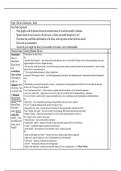Resumen
Ode on a Grecian Urn - essay plan/summary page
- Grado
- Institución
Extremely detailed A* essay plan page/summary for Keats' 'Ode on a Grecian Urn' Contains perceptive and nuanced assertions of high level context, language analysis, arguments and themes. Undergraduate level analysis for A-Level English Literature Unit 3: Poetry, The Romantic Poets
[Mostrar más]



